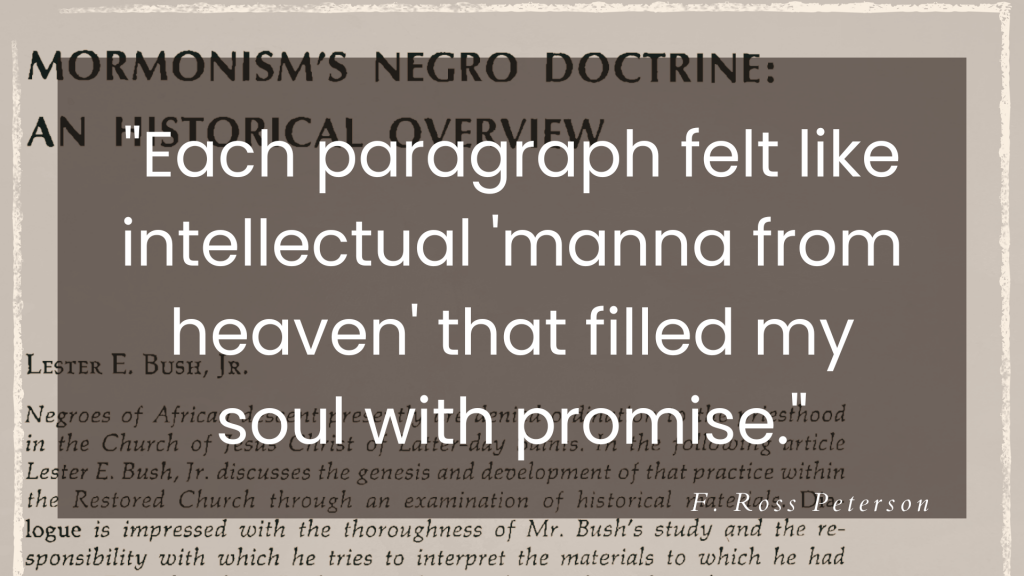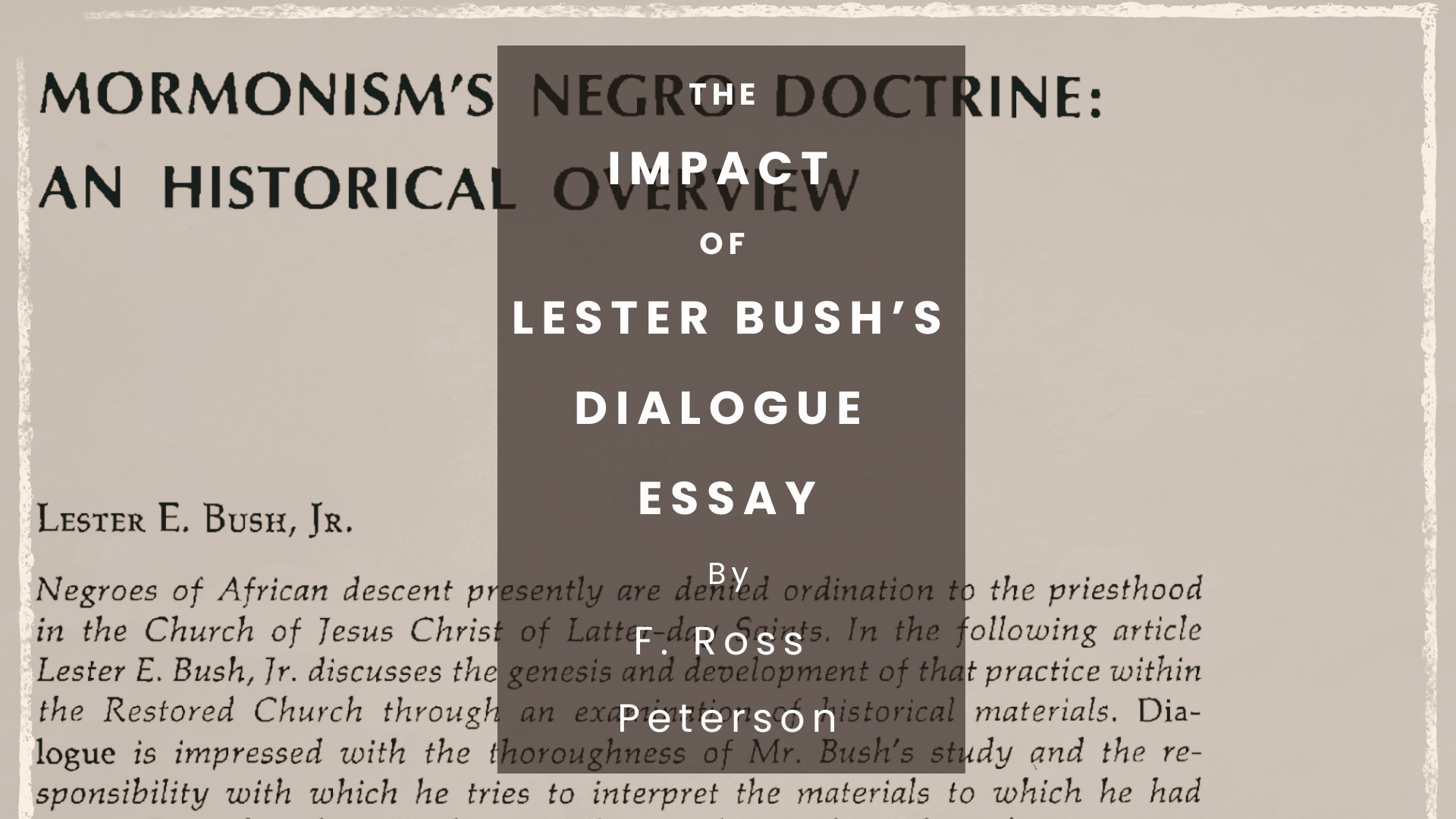Articles/Essays – Volume 57, No. 3
The Impact of Lester Bush’s Dialogue Essay
When I received a copy of Dialogue volume 8 in the spring of 1973, my mind was immersed in Watergate, Vietnam, and civil rights. Lester Bush’s article on the evolution of a policy relative to any individual of African heritage was a capstone in my personal journey relative to Black Mormons and the priesthood. There is no doubt, each paragraph felt like intellectual “manna from heaven” that filled my soul with promise. The journey had not ended, but a gauntlet had been tossed gently into the halls of 47 East South Temple Street in Salt Lake City.
My struggle with accepting second-class citizenship in a Christian religion based on Jesus’ teachings started early. I found it impossible to get my head around a judgment coming out of the premortal existence that determined a person’s status at birth. On its best day, the Old Testament and the Pearl of Great Price, save predictions of the Savior’s birth, test my concept of a loving God. When I was a ninth grader attending seminary, the instructor was explaining how the King James Bible was put together. I wondered who made the decisions about what to put in and what to leave out. So, I chose to work on the New Testament and the teachings of Jesus the next year.
Five years later, in 1962, as a missionary, I found myself forced to look the policy on race and the priesthood squarely in the eye. Professor Richard Brown of Michigan State University’s history department called our apartment and asked to visit with us. A call requesting a meeting was a rare occurrence, so my companion Robert Pommerville and I eagerly went to his home at the appointed hour. Dr. Brown introduced us to Fawn Brodie’s No Man Knows My History and Juanita Brooks’s The Mountain Meadows Massacre, but our conversation focused on the priesthood policy.[1] An activist for civil rights, he kindly suggested that we consider the policy of priesthood denial as a product of the historical times. Using the books by Brodie and Brooks, he postulated that Brigham Young had made a huge miscalculation. Dumbfounded, we listened. The early Mormons, like the Adventists, thought the Second Coming was at hand as they faced a pending civil war. Brown took us to school and reminded us that a church that was so revolutionary in the 1830s should be at the forefront of the civil rights movement, not a defender of the status quo. Pommerville and I left, went straight to MSU’s library, checked out the books, read them, and came to the conclusion that God’s chosen leaders had some repenting to do.

During our quest, we asked Dr. Glen L. Taggart, a Latter-day Saint and the dean of international studies at Michigan State, how he explained the policy. His answer: “Just tell them it is wrong.” Taggart had been involved with establishing a university in Nigeria and had been in Germany on a mission when war broke out in 1938. He told us straightforwardly that Christianity had failed Jesus by embracing racism and white supremacy.
As the 1960s progressed and the civil rights movement unfolded with assassinations, the March on Washington, murders of girls in Birmingham, the Civil Rights Act of 1964, more assassinations, voting rights, and continual demonstrations, two events added to my personal foundation and helped me develop an active voice. While I was in graduate school at Washington State University, Dialogue published a letter to the editor written by Stewart L. Udall, the Secretary of the Interior under John F. Kennedy and Lyndon B. Johnson.[2] Udall, a World War II veteran, returned missionary, and former congressman, felt a need to “lecture the Brethren.” Tired of trying to explain the policy in the middle of a civil rights revolution, he boldly advised his ecclesiastical brothers to change the policy and be part of the right side of history. It was not well received.[3]
One of Udall’s political allies, Idaho Democratic Senator Frank Church, offered me some advice during the late summer of 1968. Senator Church was campaigning in our hometown of Montpelier. After his speech, he went to my father-in-law’s barbershop for a trim. While talking about Udall’s letter and how we, as Mormons, were going to navigate racial issues in the South, I said something about not being as active in the Church. Senator Church, who was not LDS, said, “Well, you’ll never change it if you leave it.” Idaho was not a bastion of liberalism, but the senator had never ducked his support for civil rights or his opposition to the war in Vietnam. The lesson was learned.
Two years later, in early 1970, Stephen G. Taggart’s book, Mormonism’s Negro Policy: Social and Historical Origins, was published.[4] Stephen, Glen Taggart’s son, had died in 1969 of Hodgkin’s lymphoma while finishing a PhD at Cornell. The small volume was a heartfelt plea to the Church for whom he had served as a missionary in Germany to accept the fact that a policy could be changed. We had moved to Texas in 1968, and the Taggart book was quickly circulated among my university colleagues so they might understand the significance of the ninth article of faith: “We believe all that God has revealed, all that He does now reveal, and we believe that He will yet reveal many great and important things pertaining to the Kingdom of God.” I also shared the book with an African American student, Curtis McLean, who was the one nonmember allowed to play on our church basketball team. We had won the regional tournament and were going to Salt Lake City to play in the all-church tournament. Udall and Taggart provided pillars for discussion and gave a sense of the need for change.
When Bush’s article and the responses to it were published, we were back in Utah at Utah State University. I had taught African American history every year and told the class on the first day each time that I was LDS and active, but I disagreed with the policy of denying the priesthood to Black men. Suspicions were obvious, but the message of the class was clear: Change happens, and history records those changes as making a difference. Lester Bush took the best of what had been written by predecessors and analyzed the history, the culture, and the changing attitudes. Although some of the other writers in that issue tried to firmly stand behind the policy and what it meant scripturally, Bush’s approach was very simple and the conclusion clear: If you believe in Jesus’ teachings and the concept of continuous revelation, then all of God’s children are equal in His eyes. I honestly believe that Lester Bush, Armand Mauss, and others had a significant influence on changing the policy. Practical realities in South and Central America contributed as well. In my experience, the path to liberation is always fraught with difficulties. However, a heavy millstone was removed from the figurative neck of the LDS Church when President Spencer W. Kimball announced the policy change in June of 1978. Lester Bush had the courage of his convictions to challenge openly and kindly and provide documentation that testified to the accuracy of his work. He and Dialogue deserve our gratitude and praise.
[1] Fawn M. Brodie, No Man Knows My History: The Life of Joseph Smith (New York: Alfred Knopf, 1945); Juanita Brooks, The Mountain Meadows Massacre (Norman: University of Oklahoma Press, 1950).
[2] Stewart L. Udall, “Letter to the Editor,” Dialogue: A Journal of Mormon Thought 2, no. 2 (Summer 1967): 5–7.
[3] F. Ross Peterson, “‘Do Not Lecture the Brethren:’ Stewart L. Udall’s Pro-Civil Rights Stance, 1967,” Journal of Mormon History 25, no. 1 (Spring 1999): 272–87.
[4] Stephen G. Taggart, Mormonism’s Negro Policy: Social and Historical Origins (Salt Lake City: University of Utah Press, 1970).


 Back to full Issue
Back to full Issue

